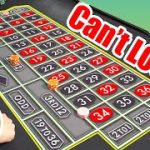Blackjack Strategy Video Source & Information:
Most gamblers, and even many card counters, have a poor understanding of odds and variance, particularly the idea of being “due.” In this video, Colin from Blackjack Apprenticeship breaks down how to understand these concepts so you can have realistic expectations and avoid making dangerous assumptions at the blackjack tables.
Article referenced at 4:33 – “The Denominator – Where ‘Due’ Happens”
Get access to our FREE Card Counting Mini-Course:
https://www.blackjackapprenticeship.com/card-counting-mini-course-opt-in
https://www.blackjackapprenticeship.com/
https://www.facebook.com/blackjackapprenticeship/
Source: YouTube








Yup this is why I shuffle track
😂😂😂you will slay the dragon
Nice , but how about the shuffle machine , the dealer doesn't finish the shoe ,just starts to put the cards back on top ???
Hi Colin. Do you have any tips on how to keep good track on how many decks there are left on a shoe? Im having difficulties on the last 3 decks on a 6 deck game
The worlds biggest scam is telling people you can make alot of money by counting cards varying your bet and using basic strategy.
The neutral cards 7-8-9 are not factored or 23% of the deck. REALLY! What if your advantage is gained at the beginning of the shoe? You will bet light trying to calculate your edge. Then you will get your ass handed to you shortly thereafter. Basic strategy is VERY flawed. It assumes 10s are usually the hidden card or the double-down card you would get.
When they use 8 decks how do you know which Queen of Hearts is in a position next to other cards?
Very few people can overcome the casino distractions to keep an exact and true count. Remember the dealer also gets those good 20s and bjs.
Most importantly, the casino nevet gets pissed or runs out of money.
don't casinos use more than one deck now? how do you beat that?
nice video. A more concrete question of variance would be, to play a $50 per bet game when shoes are rich,
1. how big should the bankroll be
2. what's expected win per hour and
3. what's the variance of win/lose for every ten hours?
Slay the dragon huh …
Your left eye is a little sparkly
If you have any questions about card counting, check out: https://www.youtube.com/watch?v=zIKEoCP5iLM&list=PL4HeBZsaiIf5zbM4Jfjx-lLJEl4Em9lwA
I think there needs to be somewhat of a caveat to refuting the Gambler's Fallacy as it relates to independent events, in the context of extreme outcomes. If I flip a coin five times in a row and get heads each time, my chances of getting heads on the eleventh flip are surely 50/50. But if I were to flip a coin a thousand times in a row and get heads each time, my probability of getting heads on the 1,001st flip is going to be pretty much 100%, and I can be fairly confident that the coin is weighted. By the same token, if a card counter is way below their EV over a sufficiently long period of time, there comes a point where that discrepancy can no longer be attributed to variance, and the card counter must consider the possibility that there is a leak in their game that they are unaware of. Colin, do you have any input on at what point deviations from EV should be looked into as something more than variance?